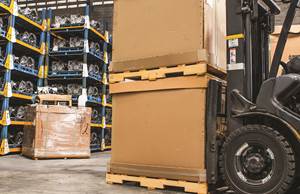Novel High-Temperature Nylon Debuts
A new class of semi-aromatic, high-temperature nylons is being introduced to the U.S. by Kuraray America in N.Y.C.
A new class of semi-aromatic, high-temperature nylons is being introduced to the U.S. by Kuraray America in N.Y.C. According to sources at this newly established U.S. marketing arm of Japan’s Kuraray Co. Ltd., new Genestar PA9T resins and compounds can compete in cost-performance with nylons 66 and 46, other high-temperature nylons and polyphthalamides, PPS, and LCP.
“Our PA9Ts are unusual in several respects,” claims Kazuhiko Maekawa, new-business development manager for Genestar. He says PA9T is a poly 1,9-nonamethylene terephthalamide. It is described as unique because it is a homopolymer, has semi-aromatic cores, and has a longer (nine-carbon) hydrocarbon chain structure than other high-temperature nylons, which are based on PA6T (six-carbon) structures. The PA6T category includes the Zytel HTN family from DuPont Engineering Polymers and Amodel PPA (polyphthalamide) supplied by Solvay Advanced Polymers.
Maekawa says these features help to explain the excellent properties of PA9T products. PA9T’s melting point is 306 C (583 F), meaning that no modification is needed to suppress the melting point (as is typically required for PA6T types) so that the material can be molded.
Another favorable feature of PA9T is water absorption almost as low as PBT and considerably lower than for any other nylon. Moisture absorption is about 10% of levels typical for nylon 46, 15% of that for nylon 66, and 33% of those for PA6T high-temperature nylons (see graph).
Genestar reportedly exhibits greater toughness at elevated temperature than do nylons 66 and 46, mostly due to PA9T’s higher glass-transition temperature (125 C) and higher crystallinity. Its resistance to abrasion and low coefficient of friction are said to exceed the performance of many other nylons as well as acetal and LCP.
Another performance advantage for PA9T is outstanding resistance to attack by chemicals and fuels. Resistance to alcohol, acid, calcium chloride, hot water, and other fluids surpasses that for almost all existing nylons, although it falls short of that of PPS. PA9T provides an excellent fuel barrier that exceeds the performance of nylons 6 and 12 by a factor of 10 and comes close to levels for ETFE fluoropolymer. This combination of properties is favorable in automotive under-the-hood applications, comments Maekawa.
Automotive & E/E uses
Another favorable feature of PA9T is water absorption almost as low as PBT and considerably lower than for any other nylon. Moisture absorption is about 10% of levels typical for nylon 46, 15% of that for nylon 66, and 33% of those for PA6T high-temperature nylons (see graph).
PA9T is offered in unmodified, glass-reinforced (33%, 45%, and 50%) and flame-retardant versions, the most promising potential markets being automotive under-hood and electrical-electronic applications. Established E/E uses in Japan include injection molded phone jacks, switches, relay devices, and many types of connectors. A number of PA9T grades are tailored for specific E/E end-uses, such as a high-flow, low-warpage grade for smart-card connectors and a high-weld-strength version for phone jacks and board-to-board connectors. Because of its high heat resistance, PA9T offers particular advantages in components for circuit boards that employ surface-mount technology and lead-free soldering, according to Maekawa.
Current PA9T automotive applications in Japan include power-steering gears and bearing retainers, where it replaces nylon 46. Fuel resistance of PA9T suits it for use in fuel-system components. Metal replacement is a driving force in other applications, which include actuator rods, inter-cooler tanks, engine mounts, and sliding parts requiring very low friction.
Kuraray currently manufactures Genestar materials in a 6-million-lb/yr resin plant and a 12-million-lb/yr compounding facility, both in Japan. PA9T is currently priced at or slightly above the level of nylon 46. However, Kuraray plans to bring on stream a new and larger PA9T resin facility in Japan in 2007. According to Maekawa, that would eventually permit Kuraray to price its high-temperature family at levels close to those for nylon 66.
Related Content
The Fantasy and Reality of Raw Material Shelf Life: Part 1
Is a two-year-old hygroscopic resin kept in its original packaging still useful? Let’s try to answer that question and clear up some misconceptions.
Read MorePrices Bottom Out for Volume Resins?
Flat-to-down trajectory underway for fourth quarter for commodity resins.
Read MoreNPE2024 Materials: Spotlight on Sustainability with Performance
Across the show, sustainability ruled in new materials technology, from polyolefins and engineering resins to biobased materials.
Read MoreWhat's the Allowable Moisture Content in Nylons? It Depends: Part 2
Operating within guidelines from material suppliers can produce levels of polymer degradation. Get around it with better control over either the temperature of the melt or the barrel residence time.
Read MoreRead Next
Beyond Prototypes: 8 Ways the Plastics Industry Is Using 3D Printing
Plastics processors are finding applications for 3D printing around the plant and across the supply chain. Here are 8 examples to look for at NPE2024.
Read MorePeople 4.0 – How to Get Buy-In from Your Staff for Industry 4.0 Systems
Implementing a production monitoring system as the foundation of a ‘smart factory’ is about integrating people with new technology as much as it is about integrating machines and computers. Here are tips from a company that has gone through the process.
Read More





















